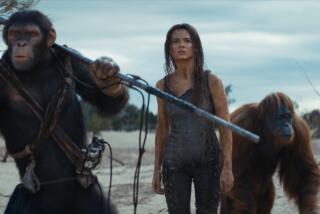‘Earth’
It would be Pollyannaish to pretend that the documentary “Earth” is without its problems, but the bottom line is, difficulties be damned, it shouldn’t be missed. What it does well is so remarkable that by the time the credits roll you likely won’t want it to end.
The Walt Disney Co. is hoping people feel that way because it has got a lot invested in this documentary from a corporate point of view, so much so that it has promised to plant a tree in honor of every moviegoer who goes to see it. Hoping to recapture the audience it had in the 1950s with its “True-Life Adventures” films, Disney is using this doc to launch an entire new label, Disneynature, devoted to the call of the wild.
If the notion of eye-popping, state-of-the-art nature photography sounds familiar, that’s because this film is the direct descendant of “Planet Earth,” the astonishing 11-hour BBC series that went to more than 200 locations in 64 countries, played widely on the Discovery Channel and sold millions of DVDs.
In fact, though the framework and focus of the theatrical feature are different from the TV series, an estimated 60% of “Earth” footage has already been seen at home. Although this is not ideal, the reality is that so much of that footage is so compelling that it’s a pleasure to see it again on a theatrical-size screen.
Yes, fans of the series will remember the great white shark leaping completely out of the water with a seal in its mouth, as well as aerial shots of caribou without number on their annual migration. There are vistas magnificent enough to give you vertigo, glimpses of a world that human beings rarely see, and experiencing them for a second time is hardly a hardship.
In keeping with the Disney approach, the nature photography this time around, co-directed by Alastair Fothergill and Mark Linfield and shot by some 60 cameramen, is focused on the trials of three animal families.
Up in the Arctic, a mother polar bear and her two cubs make an appearance and look for food in the barren snows. In Africa’s considerably warmer Kalahari Desert, elephants fight off drought as they head for the promised lushness of the Okavango Delta. And, under the sea, a humpback whale and her calf navigate the 4,000-mile migration that is the longest of any for a marine mammal.
Though these three family groupings get star billing, “Earth” has room for other animals as well, including several kinds of birds, baboons for comic relief and all those caribou.
No matter what animals are on screen, the theme of “Earth” is always the struggle of the different species to find enough to eat and survive. In fact, it is the fang-and-claw stuff that is invariably most compelling and the infrared nighttime shots of a pride of lions making a rare attack on an elephant are riveting.
One of the interesting tensions in “Earth” is between the implacability of the animal world and Disney’s determination to make a family film with a G rating.
So, while it is clear in several sequences that the end of an animal’s life is seconds away, the film always cuts away before the actual coup de grace is delivered.
Less successfully negotiated is the tenor of the voice-over delivered by James Earl Jones in what is definitely not his Darth Vader tone. Although the “Planet Earth” narration was crisp and to the point, the talk here is much too cutesy and anthropomorphic for its own good.
These unfortunate lines include describing baby elephants as being on “their first road trip with the family,” a bird of paradise portrayed as “cleaning up for the big date tonight” and complimenting obedient polar bear cubs by comparing them to “human beings who don’t always listen to their moms.”
These frequent remarks are a constant irritant but they’re not deal breakers. Even if you have to put cotton in your ears when you see “Earth,” if you keep your eyes wide open you’ll be amply rewarded.
--
--
‘Earth’
MPAA rating: G
Running time: 1 hour, 29 minutes
Playing: In general release
More to Read
Only good movies
Get the Indie Focus newsletter, Mark Olsen's weekly guide to the world of cinema.
You may occasionally receive promotional content from the Los Angeles Times.








